Managing credentials for online courses can quickly become overwhelming, especially as enrolments surge and expectations for instant, secure proof of achievement rise.
I've seen how manual processes lead to errors, delays, and frustrated learners. Many providers struggle to keep up with audits, compliance, and the demand for digital badges that actually motivate students.
In this guide, I'll break down what credentialing software really does, the features that matter most, and how digital platforms compare to old-school manual methods. You'll see real-world results, from reduced admin hours to higher course completion and viral badge sharing.
I'll also walk you through key demo tests, pricing models, and common pitfalls to avoid. By the end, you'll have a clear, practical checklist for choosing the right credentialing software—so your team can scale with confidence and your learners get the recognition they deserve.
What is Best Credentialing Software?
Setting the Stage: Credentialing in the World of Online Education
Credentialing sits at the core of modern online education and the MOOC (Massive Open Online Course) movement.
With record numbers enrolling in online courses, there’s a growing need for reliable, scalable ways to verify genuine student achievement.
A robust credentialing system doesn’t just protect an institution’s reputation—it allows learners to carry credible, portable proof wherever they go.
An institution’s brand reputation can be enhanced by digital credentials, as they provide tangible and credible proof of the value of their programs. In one case, shared certificates generated thousands of impressions and clicks, leading to a higher number of inquiries and enrollments.
And for organisations, it means recognising large cohorts without a logistical headache. Imagine thousands of graduates clamouring for proof of success—how do you keep up?
Credentialing Software: Definitions and Building Blocks
So, what actually is credentialing software?
At its core, credentialing software is a digital platform that lets educators create, issue, track, and verify student achievements online.
In practice, these achievements become digital credentials—electronic certificates, badges, or even micro-credentials designed for instant verification and effortless sharing.
It’s like a digital passport for your learning journey—a badge you can proudly show off, anytime, anywhere.
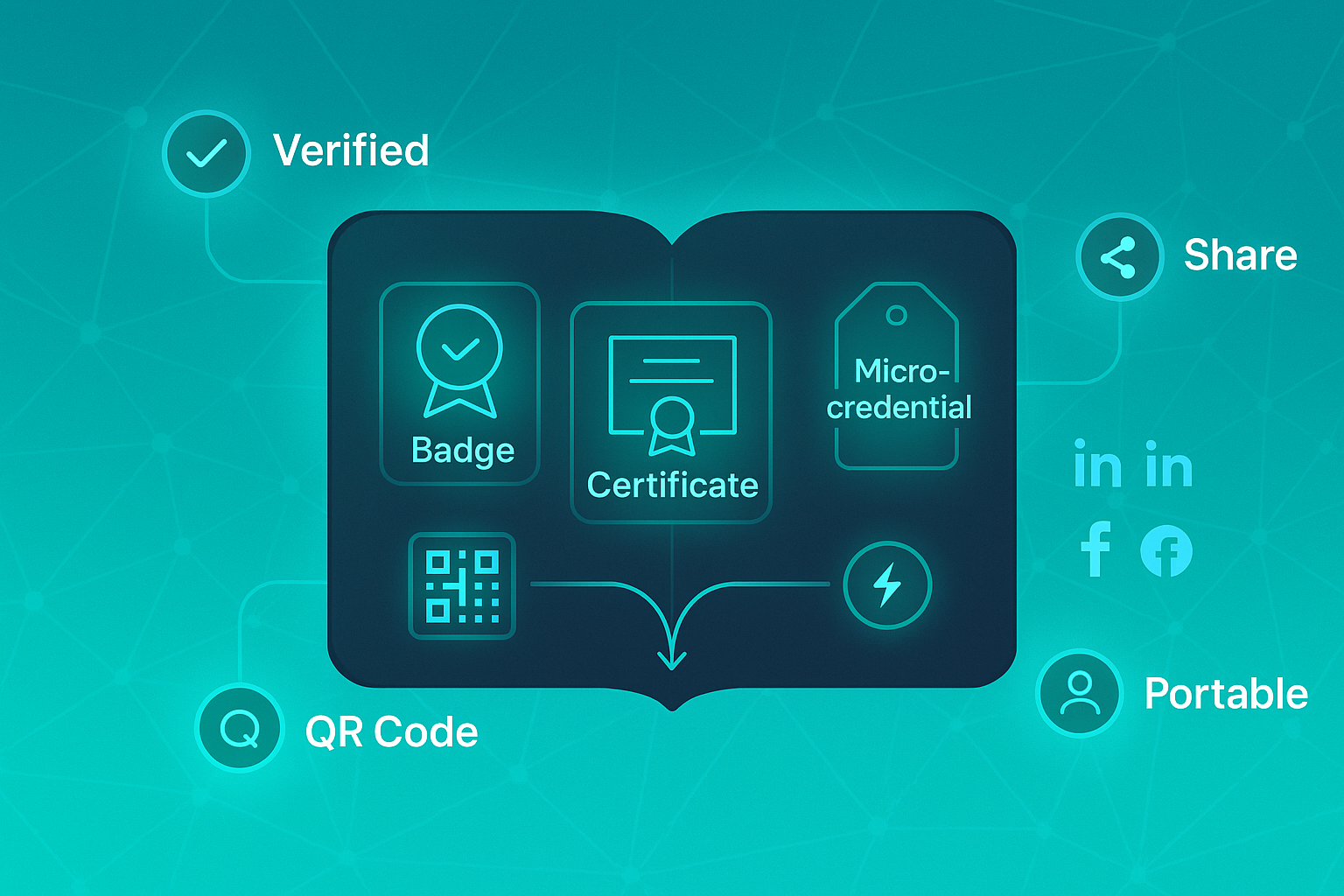
It helps to clarify a few essential terms:
- Digital credentials
Electronic proof of skill—a badge, certificate, or micro-credential tied to a real accomplishment. - Verification technologies
Methods such as blockchain that ensure credentials are genuine and tamper-proof. - Learning Management Systems (LMS)
Platforms that deliver online courses, often fully integrated with credentialing software to create a seamless learner experience.
Core Features: What Makes Credentialing Software Tick?
Credentialing platforms are built around several essential elements.
You’ll typically find:
- Credential Creation
Allows custom, recognisable achievements tailored to unique course structures. - Issuance Capability
Automates delivery to hundreds or thousands of learners—no more manual bottlenecks. - Verification Feature
Gives employers and institutions real-time, secure validation—no emails or faxes required. - Tracking and Management
Offers a central dashboard to keep records accurate and accessible for all.
Think of it as moving from a shoebox full of certificates to a searchable, organised digital cabinet.
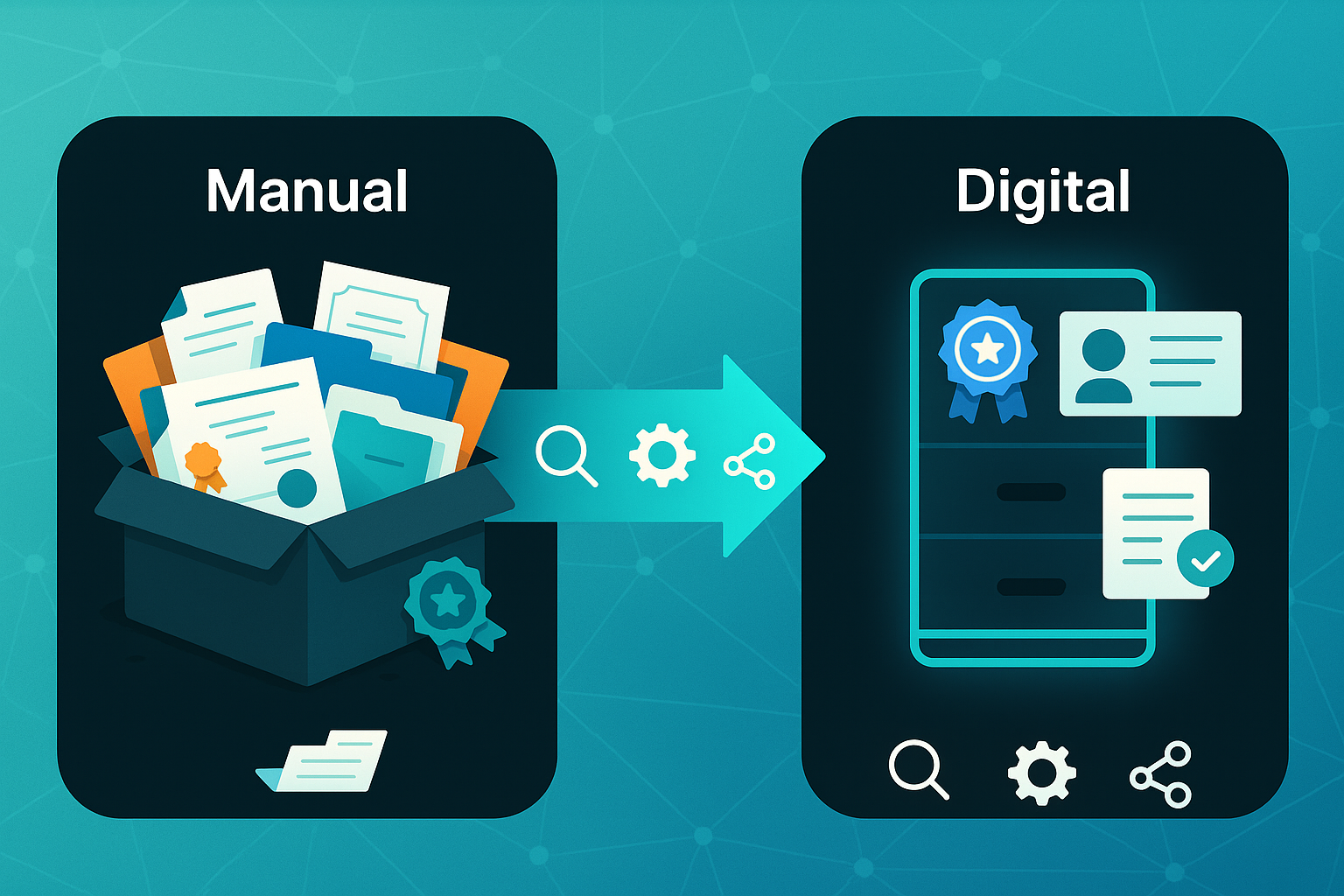
Digital vs Manual Credentialing: How Do They Compare?
But why go digital? Picture managing credentials with paper, spreadsheets, and slow turnaround—is that sustainable as class sizes grow?
Digital credentialing brings everything onto a single platform: automation, instant validity, transparency.
Manual systems can feel like running a relay race in slow motion—paper gets lost, admin piles up, verifying one certificate at a time just can’t scale.
Unique Demands for Online Training and MOOCs
For online learning providers and MOOCs, credentialing software addresses unique challenges.
Here’s what’s non-negotiable:
- Mass Recognition
Handle high-volume credentialing for students globally. - Digital Reputation Building
Enable learners to showcase achievements and build an online academic footprint. - Regulatory Recordkeeping
Meet compliance needs for audits and future review.
These aren’t just perks—they’re essentials for open, accessible online education.
Boundaries and Persistent Myths
Let’s set the record straight. Credentialing software for education is not used for healthcare licensing, HR records, or IT authentication.
And here’s a misconception: some believe digital credentials are just PDFs. In reality, these platforms transform recognition—adding advanced authentication and robust record management.
Is it any wonder that so many institutions have shifted away from paper-based methods?
Why Does This Matter for Online Educators?
For digital education providers, credentialing software isn’t just another tool—it’s critical infrastructure.
It boosts motivation, elevates institutional prestige, and underpins the broader digital transformation of education.
So, what kind of impact do these systems really have on student outcomes and organisational efficiency? That’s where things get interesting next.
Key Benefits of Credentialing Software for Online Course Providers: High-Impact Outcomes for Digital Education
Reduce Course Administration by 60%
MOOC platforms like edX and Coursera report reductions in admin hours of up to 60% after switching to credentialing software. What used to take weeks now happens in less than a day for large cohorts.
Teams avoid spreadsheets and endless emails thanks to automation for batch processes and notifications. For providers running multiple courses, these gains let staff focus on what matters, especially during peak enrolment.
A case study on a Swedish university's automated MOOC accreditation system found it enabled the issuance of formal credits to over 10,000 learners in the first year, a task deemed 'impossible to handle manually' with the university's available administrative resources.
Audit Preparation 70% Faster
Audit season becomes easier when credentialing platforms connect with LMS tools like Canvas and Moodle. Digital systems centralise records, automate reminders, and enable instant data exports.
This direct comparison highlights how digital workflows mean less staff time, fewer errors, and better confidence in regulatory reviews:
| Compliance Control | Manual Credentialing | Digital Credentialing |
|---|---|---|
| Audit Log Gathering | Staff must collate spreadsheets | Instant report export via dashboard |
| Certificate Expiry | Manual reminders and checks | Automated alerts and tracking |
| Reporting for Regulators | Fragmented spreadsheets, manual collation | Real-time interface to LMS data |
Digital workflows keep records clear and current, helping smaller teams stay compliant and larger platforms avoid extra staffing. Scalability grows, risk drops, and compliance becomes predictable and secure.
As a result, audit readiness shifts from a scramble to a strength. Teams move from reactive cleanup to proactive confidence.

Boost Course Completion by 22%
Digital badges motivate learners. After introducing milestone badges, FutureLearn saw completion rates increase by 22%. These credentials reward progress and help build portfolios for new opportunities.
Grow Enrolments by 30%
Sharing credentials online provides effective, organic marketing. LinkedIn Learning and similar platforms experienced 30% enrolment growth when digital credentials were shareable.
Around 40% of Udacity students now showcase certifications publicly. Each shared credential brings trusted referrals, boosting organic course growth.
Issue Tamper-Proof Credentials: Blockchain Security and Speed
Security is crucial. Blockchain-based systems used by MIT and the University of Nicosia reduce credential fraud by 90% and cut employer verification wait times by 80%.
These credentials are robustly authenticated, making them valuable for job seekers and employers.
Scale Affordably: Pay-Per-Credential Pricing Model
Pay-per-credential pricing like VerifyEd’s offers flexibility. Fees start as low as £0.75 for large batches, unlike annual or per-student rates that can balloon as volumes change.
Flexible pricing lets providers match costs to actual credential activity. This table compares fixed versus flexible models:
| Pricing Model | 500 Credentials | 5,000 Credentials | 50,000 Credentials |
|---|---|---|---|
| Annual Flat Fee | £4,000 | £9,500 | £18,000 |
| Per-Student Fee | £5,000 | £18,000 | £120,000 |
| Pay-per-Credential (VerifyEd) | £375–£500 | £2,500–£3,750 | £37,500 |
Annual and per-student pricing penalises variable course sizes and locks providers into expensive contracts. Pay-per-credential models enable smarter planning and easier adaptation to shifting demand.
Credentialing as Competitive Infrastructure
Combining speed, compliance, engagement, growth, security, and low-cost scaling makes credentialing software core infrastructure for digital education. Next, we explore how these platforms deliver these results in practical terms.
Looking to improve your course sales, marketing & experience?
Book a free course optimisation strategy call with one of our specialists.
Book a call
Manual vs Digital Credentialing: Understanding the Differences
Manual Credentialing: Key Workflow and Pitfalls
Manual credentialing is a bit like building a wall brick by brick—slow, prone to mistakes, and not exactly scalable.
Let’s walk through what this actually looks like for a typical online course provider. You start by exporting course completion data from LMS platforms such as Canvas or Moodle.
Then, you’re stuck merging certificates, copying details into Word or Docs templates one at a time. That’s already tedious.
After this, drafts need to be sent for approval via email—think Outlook or Gmail. This often leads to version mismatches and endless message trails.
Once everyone’s happy, you distribute PDFs, again by email, keeping a separate log so you don’t lose track.
And when it comes to status tracking or verification, it’s back to slow email exchanges. This becomes especially tricky across international teams. Errors slip in all too easily.
Here’s what those bottlenecks lead to:
- Error rates
Large cohorts see error rates as high as 10–15%. - Processing delays
Handling batches of more than 20,000 certificates can mean 7–14 days of manual effort.
Digital Credentialing: Automation and Scale
Shift to digital platforms such as Badgr, Accredible, or even pay-per-credential approaches like VerifyEd, and the landscape completely changes.
Now, LMS integrations automatically trigger bulk certificate generation—no more endless copying and pasting.
Approval cycles happen through live dashboards, and delivery moves to secure, clickable links.
Real-time verification is standard, cutting friction for both admin teams and learners.
Let’s see how this stacks up:
| Provider | Manual Workflow Time/Error | Digital Workflow Time/Error |
|---|---|---|
| Coursera/edX | 7–14 days, 5–12% lost/mismatched | <1 day, <1% lost |
| FutureLearn | 7–10 days, ~9% errors | Seconds, <1% errors |
| North Carolina CTE | 2–4 weeks, 10–15% errors | Hours, <2% errors |
| WGU | 7–10 days, 8% mismatched | Minutes, <1% lost |
| Udacity | 7–10 days, 10% lost | Instant, <1% lost |
Looking at the numbers, it’s clear why more institutions are swapping paper for pixels. Providers are reporting up to an 80% reduction in errors and turnaround times dropping from weeks to minutes.
There’s more. Learners can now instantly share their achievements on LinkedIn or with employers.
Over 40% of Udacity students take their digital badges public, all without delays or missing records.
Digital platforms also come with live analytics. Administrators can track badge views, claim rates, and social sharing.

Automated email sequences follow up with learners, perhaps a course offer just when motivation peaks.
These tools transform credentials into marketing gold.
They drive retention and referrals while helping providers refine enrolment strategies with real-world data.
So, manual might feel familiar, but digital credentialing is where real efficiency, reliability, and impact begin.
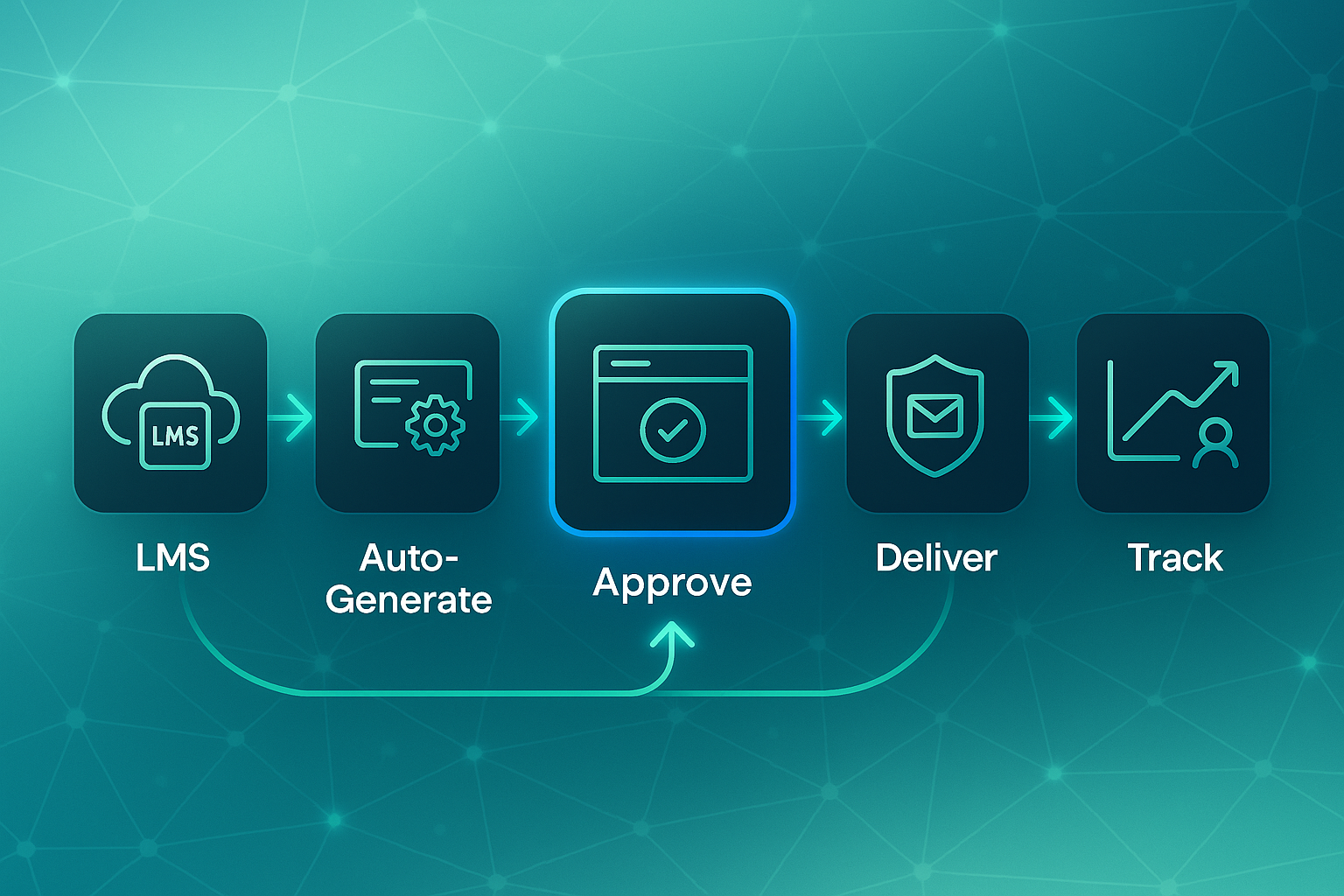
Must-Have Features in Credentialing Software: The Essentials for Scale and Trust
Why Deep Feature Scrutiny Matters for Online Credentialing
Choosing credentialing software isn’t just about ticking boxes—it’s about making sure your platform can genuinely scale, verify, and integrate without hiccups. The core features you select will shape enrolment growth, compliance, and just how efficiency flows through your daily operations. If a critical element is missing, bottlenecks and credibility issues soon surface.
Design and Branding: Customisation, Impact, and Batch Consistency
It’s worth starting with how your credentials actually look. Software options like Certopus and Hyperstack Credential Cloud stand out here. They let you build pixel-perfect designs, apply multi-language templates, and automate branding—ensuring every batch, even those with 1,000+ badges, stays visually on point.

Certopus pricing begins at $299/year (Standard) for 100 credentials each month, rising to £749/year (Professional) for analytics and white-label perks. Hyperstack ranges from $49/month (1,000 annual recipients) up to $233/month (10,000 recipients). In contrast, iSpring and OpenBadgeFactory stick to basic templates, limiting options for a distinctive look.
When it comes to platform must-haves for branding, here’s what really matters:
- Live editor/metadata
Enables dynamic logo and layout changes for effective batch branding. - Batch design automation
Applies branding across >1,000 credentials, keeping every credential consistent.
Automated Issuance: Speed, Scaling, and Error Reduction
Delivering credentials at scale means you need speed and almost no errors. Certopus and Hyperstack handle 1,000 certificates in under 15 minutes, with automatic error logging and SSO (Single Sign-On) sync to prevent mistakes.

OpenBadgeFactory’s manual import takes over an hour for 500+ records, demanding extra effort to catch errors. Automated tools lower issues from 10% down to under 1%.
For reliable high-volume issuance, these capabilities are essential:
- Issuance speed
Delivers 1,000 certificates swiftly—under 15 minutes. - Error logging/SSO
Automates error tracking and user data syncs for smooth delivery.
Verification and Security: Blockchain and QR Outcomes
Security matters when reputation is at stake. VerifyEd offers blockchain verification that checks each credential in under 30 seconds. Certopus and Hyperstack also anchor batches to blockchain and use QR verification (on paid plans), while OpenBadgeFactory sticks to static QR codes.

To inspire trust, look for these key protections:
- Blockchain verification
Credentials receive verification in 30 seconds or less. - Outcome specificity
Green “Verified” dashboard indicator confirms blockchain-secure status.
Analytics & Audit: Management, Export, and Compliance
When managing large numbers of learners, rapid export and audit trails become vital. Certopus Professional and Hyperstack can export up to 100,000 records in under 10 seconds, confirming completion with a dashboard alert. OpenBadgeFactory, by contrast, caps CSV reports at 1,000 and often takes 20 minutes.
Expect the following in your analytics toolkit:
- Export speed/limit
Handles 100,000-record exports in just seconds. - Audit outcome
Clear dashboard indicator for export completion and compliance.
Integration & Automation: APIs, Workflow, LMS Compatibility
Your credentialing software should plug into your toolset for smooth automation. Certopus and Hyperstack offer REST APIs and Zapier for over 100 types of workflow connections. Certopus and iSpring support Moodle integration, but iSpring’s API range is smaller. OpenBadgeFactory relies on manual CSV management, slowing things down at larger scale.
Look for these integration and automation priority features:
- API and workflow integration
REST APIs and Zapier connections support automated tasks and smooth compatibility. - Bulk import and dashboard alerts
Gives import alerts and success/error notifications on the dashboard, safeguarding major rollouts.
By evaluating how each platform delivers on branding, speed, security, audit readiness, and integration, you avoid costly surprises and support seamless digital recognition for your learners.
Next, let’s dig into how blockchain is transforming trust and compliance for digital credentials.
Verification Technologies in Credentialing: The Blockchain Advantage
Building Trust and Authenticity for Digital Credentials
These days, if you want real confidence in digital credentialing, blockchain verification is setting the gold standard. Here’s why it works: when a university or online training provider hands out a credential, it’s cryptographically signed and its hash anchored to a blockchain. That could be on something public like Ethereum, or a more private option such as Hyperledger Fabric.
Only the credential’s metadata gets recorded on-chain, while personal data stays safely off-chain to preserve privacy.
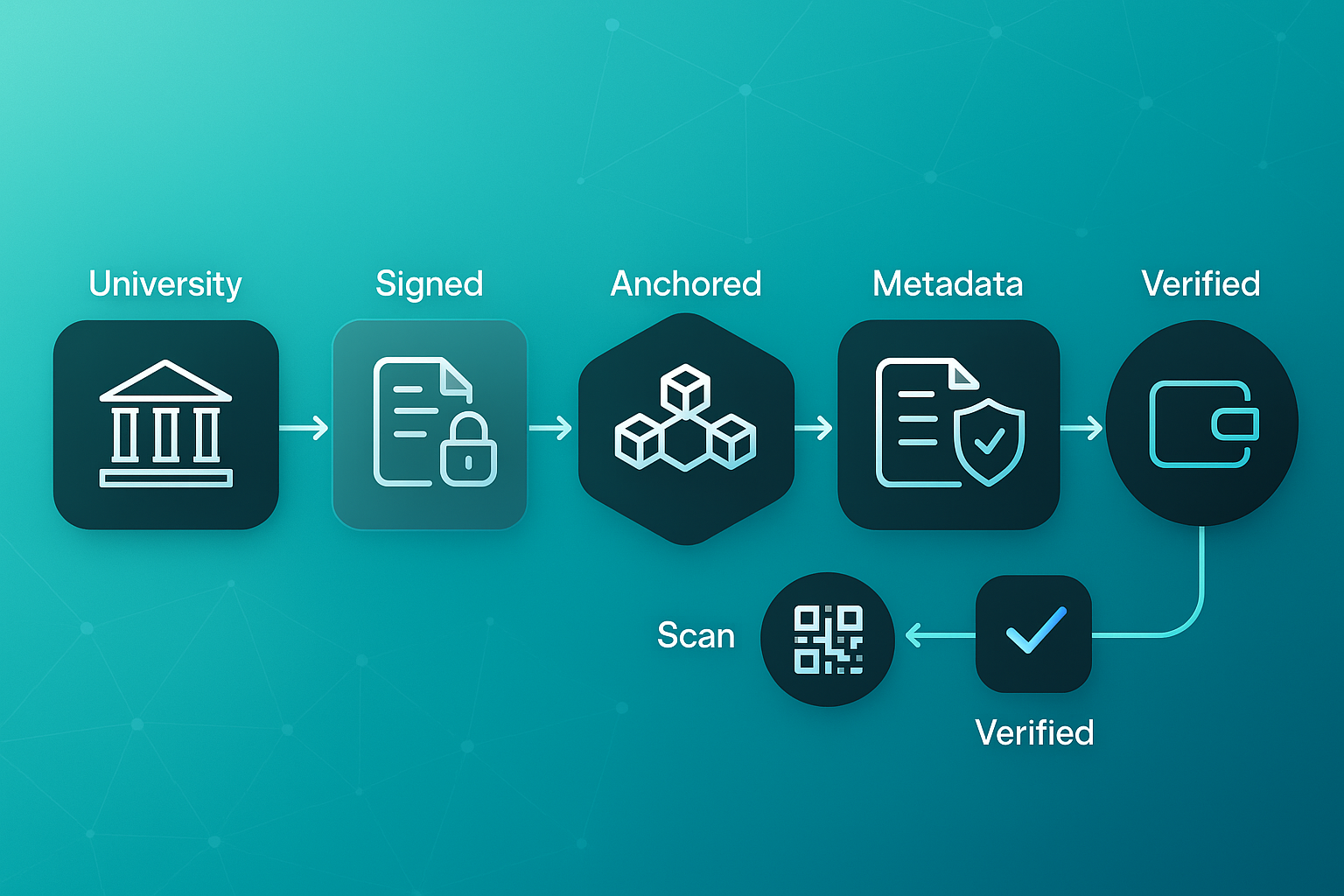
For the graduate, things are refreshingly simple. Credentials live in a digital wallet, and onboarding usually takes a couple of guided steps.
- Digital wallet examples
Blockcerts Wallet, LearnCard, Sertifier
When it comes time to prove an achievement, just scan the QR code or click a secure link—verification happens instantly.
The system checks the hash and digital signature, confirming authenticity against the blockchain—no emails, no middlemen. You’ll see times as fast as 3–6 seconds on permissioned blockchains, and around 5–18 seconds on public ones.
- Major blockchain-based credential platforms
MIT’s Blockcerts, University of Melbourne’s Learning Machine, VerifyEd
Hundreds or thousands of credentials can be issued together in a single, efficient transaction.
Advantages Over QR/URL-Only Methods
Compared to the old-fashioned QR/URL systems, blockchain brings a whole new layer of security and usability. Take a look at these standout advantages:
- Tamper-proof records
Blockchain credentials are permanent and tamper-evident, outlasting server outages. - Instant, automated checks
Verifying a credential only takes a blockchain lookup—no delays or chasing down issuers. - User ownership
Credential wallets let graduates share instantly and control their own data. - Scalable, fast throughput
New systems verify 1,000+ credentials per hour, running up to 75% faster than manual or centralised methods.
These advantages make blockchain credentialing stand out over QR/URL-only approaches.
Challenges and Considerations
Of course, it isn’t all smooth sailing. A few hurdles come with the territory:
- Integration complexity
Blockchain set-up can take 6–12 weeks, making it trickier than quick QR-style alternatives. - Learning curve
Some users have questions about getting started with wallets, though step-by-step guides now cover most issues. - Revocation processes
Making changes or revoking credentials means updating the blockchain—while QR systems let you edit or pull credentials instantly online.
Nevertheless, providers are weighing the reliability and long-term value offered by blockchain.
Non-blockchain options like those from Credly, Accredible, or OpenBadgeFactory still depend on provider servers being up, which means you’ll see about 0.8% downtime a month.
Blockchain-backed tools, on the other hand, offer 99.99% verifiability—your record stays trusted even if the original issuer disappears.
In a study comparing credentialing methods, the average time until proof of credentials for the traditional method was 1,232.6 hours, while the average time for the blockchain/DMS method was a mere 0.002 hours.
With open standards and API integrations, recognition becomes truly universal.
What’s driving adoption? Data from 2024 saw Hyland Credentials and VerifyEd clocking in with 5-second average verification speeds and user satisfaction rates soaring 30–40% higher than manual or QR-only setups.
Industry examples of blockchain-enabled credentialing include MIT, University of Melbourne, and providers using VerifyEd.
Blockchain-enabled credentialing delivers unmatched trust, speed, and reliability. The next piece of the puzzle is how these advances make compliance, audit-readiness, and reporting much easier for everyone involved.
Compliance, Audit-Readiness, and Interoperability in Digital Credentialing
Credentialing software for online education and MOOCs faces tough requirements these days—compliance, privacy, seamless system connections, and future readiness are all essential. Platforms help organisations meet regulatory demands, smooth out audits, protect sensitive learner data, and keep credentials portable across borders and platforms by integrating advanced features that address these needs collectively.
Compliance Audits and Data Security: Automated Trails and Retention
Modern digital credentialing platforms like Certopus, Hyperstack, and Badgr shine in streamlining compliance and data security. Every action, from creation to revocation, is logged with precision, including timestamps, user IDs, and field changes. Instant export ensures that if a regulator or auditor comes knocking, all logs are ready, while role-based access and SSO integration with services such as Okta restrict who can perform sensitive changes. Automated data retention tools allow for auto-deletion or archiving—making it simpler to stay aligned with regulations like GDPR. If a massive MOOC concludes with 15,000 completions, every credential update or deletion is recorded, turning audits from a scramble into a manageable process.
Interoperability and Integration: Open Standards and Real-Time Sync
Cross-platform openness is now fundamental, with solutions like Credly, Badgr, and Blockcerts using IMS Global Open Badges and W3C Verifiable Credentials. This guarantees that credentials can move seamlessly between LMS platforms such as Moodle and Canvas, as well as HR and identity systems. APIs and plugins enable badges to be issued automatically whenever a course is completed, keeping user data in sync without manual file handling. If a grade transfer or data mismatch arises, audit logs allow admins to diagnose, remap, and recover affected batches quickly so no achievement is lost.
Portability and Future-Proofing: Universal Wallets and Open Verification
When learners want to take their credentials beyond a single provider, today’s platforms let badges move to universal wallets, such as Blockcerts and Trinsic. Here, every credential remains independently verifiable for a lifetime, supporting international job searches and multi-institution learning. Decentralised identity standards and blockchain anchoring further ensure that digital credentials are trustworthy even if the original issuer switches platforms or ceases operation. By using open protocols like OpenID4VCI and DIDs, organisations avoid being locked in and can reliably scale and adapt as technical standards evolve. Digital credentialing not only guarantees security and compliance now, but also sets the groundwork for global, lifelong recognition.
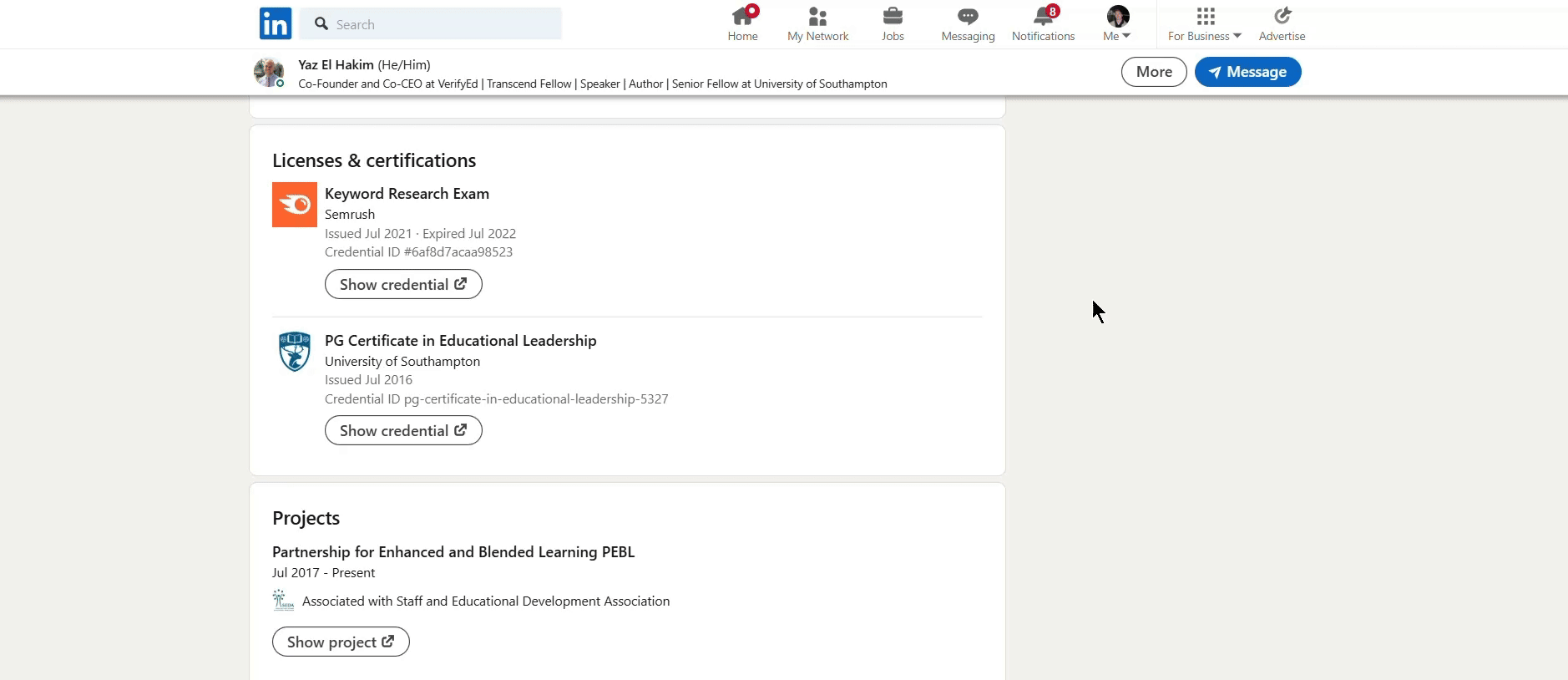
Pricing and Scalability in Credentialing Software: Matching Your Needs
Finding the right credentialing software is all about pairing your budget with the batch sizes you anticipate—and making sure automation scales as you grow. If you run online courses or MOOCs, you need a platform that delivers speed and flexibility without breaking the bank.
Exact Pricing, Volume Discounts, and Automation Essentials
To help you pinpoint what matters, see how leading platforms compare for pricing, volume discounts, and bulk issuance speed. Each factor below affects your ability to manage cohorts efficiently.
| Platform | Starting Price (Monthly) | Volume Discount | Batch Capacity & Time | Automation Features |
|---|---|---|---|---|
| Certopus | Custom/Quote | Yes (>3,000/year) | Thousands/batch, minutes–hours | API integration, batch tools |
| Hyperstack | Custom/Quote | Yes (>10,000+) | Thousands/batch, minutes–hours | Dynamic API/LMS integration |
| OpenBadgeFactory | Free basic; €220–1280/year | Custom (>5,000) | Thousands, ~minutes for 1,000+ | API, LMS, metadata |
| Accredible | ~$100/month | Yes | Thousands, <2 hours for 10,000+ | API/LMS/bulk email |
| Credly | $100–400/month | Yes | Thousands, minutes | API, HRIS/LMS |
| Badgr | Free to $100+/month | Yes | Thousands, minutes–hour | Open Badge API, LMS triggers |
| Sertifier | $50–150/month | Yes | Thousands, minutes–hours | API, email automation |
Volume discounts typically kick in above 3,000 credentials per year with Certopus, with higher thresholds for others like Hyperstack or Accredible. Larger cohorts (5,000+) trigger custom pricing on platforms such as OpenBadgeFactory, Credly, and Sertifier.
Bulk Certification: Speed and Reliability Benchmarks
When large batches matter—for graduation days or big campaigns—speed is everything. Here’s how major providers handle volume under pressure:
- Certopus
Batch issues 1,000+ credentials in under 15 minutes; supports up to 30,000 at events. - Accredible
Delivers 100,000+ certificates or 10,000 badges in under two hours. - OpenBadgeFactory
Processes 1,000+ badges in 20 minutes via CSV/API. - Badgr
Supports thousands for MOOC cohorts, all in under an hour.
Platforms like FutureLearn have certified 22,000 learners in one day. Most automated tools now keep lost or mismatched credentials below 1%—with instant dashboard alerts for peace of mind.
Cost Optimisation for MOOC and Growth Providers
To keep credentialing affordable and scalable, focus on these key tactics:
- Align credential volume to plan tiers
Estimate annual cohorts and negotiate discounts for batches over 5,000. - Leverage analytics and automation
Monitor usage, avoid bottlenecks, and keep admin costs controlled as you scale.
If you target sub-1% errors and batch completion inside 24 hours, today’s leading platforms measure up. Next, we’ll explore how integrations and LMS compatibility complete the digital credentialing picture.
How to Choose Credentialing Software: Specific Demo Checklist for Online Course Buyers
Choosing the right credentialing software means seeing how it performs under pressure, not just trusting sales pitches. A well-planned demo helps you side-step costly surprises and ensures your platform is truly ready for MOOC-scale education.
Badge Portability & Standards (Open Badges 3.0)
Badge portability is key for reputation and flexibility. This quick sequence lets you test whether credentials move seamlessly between systems and social platforms.
- Request export of a credential using Open Badges 3.0
Exports a credential using the Open Badges 3.0 standard for universal compatibility testing. - Validate it with Badgecheck.io and IMS Global Validator—processing must be under 2 minutes
Use Badgecheck.io and IMS Global Validator to verify the credential. Ensure processing completes in under 2 minutes for efficiency. - Try importing to LinkedIn and Blockcerts Wallet, checking that all badge fields appear
Import the credential to LinkedIn and Blockcerts Wallet. Confirm all badge fields and claims are retained and visible after transfer.
- Pass
Full import with all claims and details visible. - Fail
Metadata is lost or files are unsupported during transfer.
Bulk Issuance and Automation Stress Test
Fast, error-free bulk issuance matters for handling large course cohorts and scaling efficiently. Running this demo will reveal any bottlenecks or weak points in your process.
- Ask the vendor to issue at least 5,000 credentials, using real or sample records
Request the vendor to process a minimum batch of 5,000 credentials to simulate a real-world cohort. - Time the run: Certopus (1,000 in 15 minutes), Accredible (10,000 in under 2 hours), VerifyEd (5,000 in 30 minutes)
Record how long the issuance takes and compare to standard benchmarks for speed and reliability.
- Expected benchmarks
Sub-1% error rate; instant dashboard alerts during batch processing. - Fail
Issuance takes over 30 minutes for 5,000 credentials or errors are unreported.
Blockchain Verification & Revocation Drill
Security and trust depend on immediate verification and revocation. This test proves whether credentials are genuinely reliable.
Before choosing, request a blockchain-issued credential demo using Blockcerts Verifier.
- Benchmarks
Verification completes in under 6 seconds online or offline; revocation updates within 1 minute. - Fail
Verification cannot occur offline or badge status updates are slow.
Workflow Integration Test (LMS, SSO, CRM)
Effortless integrations reduce admin burden and support headaches. A solid demo here proves speed and reliability.
- Request demo integration with MoodleCloud LMS, Google SSO, and Salesforce CRM
Ask for demonstration of integrations with MoodleCloud LMS, Google SSO, and Salesforce CRM software. - Credentials should issue automatically post-completion
Observe that credentials are issued automatically after course completion without manual CSV handling.
- Pass
Integration setup completed within 1 hour; no need for manual CSV imports. - Fail
Process requires manual steps or automation experiences delays.
Analytics, Reporting & Social Engagement Review
Efficient reporting and analytics keep you audit-ready and support growth. This test helps you spot any data bottlenecks.
Ask for export of a 10,000-record batch from the dashboard.
- Benchmarks
Certopus completes export in under 10 seconds; Accredible allows flexible segmented exports; OpenBadgeFactory processes 1,000+ records in over 5 minutes; filters and tracks share rates by cohort, course, and type. - Fail
Exports are slow or reporting features are locked behind premium tiers only.
Support, Onboarding & Cost Transparency
Responsive support and clear costs are deal-breakers for long-term reliability. This mini-trial reveals the vendor’s commitment.
Issue 100 credentials as a trial admin, then evaluate:
- Benchmarks
Onboarding completed within 5 days; support replies in under 4 hours. Certopus: £999/year for 12,000 credentials. VerifyEd: £0.75 per credential after 10,000. Accredible: $960/year for 1,000 badges. - Pass
All listed features are included; costs and inclusions are clearly stated. - Fail
Delays in onboarding or support, vague or hidden pricing, or missing essential features.
A thorough demo using this checklist makes sure your final choice delivers automation, scalability, security, and cost control—so you gain confidence and avoid regrets.
Sign up to try our platform for free
Your application may be approved without further action from you, or we might reach out in case we have any questions.
When you're approved, you will get a welcome email from VerifyEd. You may need to check your spam folder for this.
Credentialing Software in Action: Case Studies and Outcome Metrics
How Power Business School Used Sertifier to Transform Credentialing
Let’s start with a real-world turnaround. Back in 2024, Power Business School replaced its slow, manual certification with Sertifier, and the results were striking.
They issued more than 50,000 credentials—each batch completed in under 15 minutes. That’s a massive shift from weeks of work.
Staff errors dropped by 90%. Lost credential support requests decreased by 88%, freeing up staff to focus on engaging students and developing new courses instead of chasing paperwork.
With students receiving badges instantly, satisfaction levels took a noticeable leap.
Accredible and Badgr: Higher Completion and Retention
Similarly, the impact on course completion and retention is clear.
Accredible’s system, adopted for MOOCs, saw completion rates climb by 20–30% compared to manual methods.
Over at Badgr, digital badge programmes—think of each badge as tangible proof of achievement—delivered retention between 89–91%.
FutureLearn and North Carolina CTE found repeat enrolment rates rising 18–24% after moving to digital badges.
Learners were building living portfolios—collections of all their earned digital credentials—creating new pathways for motivation.
Viral Sharing and Organic Growth: Certopus, Sertifier, VerifyEd
Building on these successes, analytics from Certopus and Sertifier showed that about 90% of badges go public on LinkedIn.
For events like the EUvsVirus hackathon, this viral sharing turned into a 30% enrolment bump as peers referred friends.
Badge virality is now a real force in organic course growth.
Stackable Credentials: Longer Engagement and Repeat Enrolment
Platforms like Coursera and edX are seeing even wider effects thanks to stackable credentials.
- Coursera’s Specialisations
Yielded 22% more repeat enrolment. - edX MicroMasters portfolios
35% of learners completed entire MicroMasters portfolios. - Udacity Nanodegree users
73% built out full digital portfolios.
Analytics-Driven Growth: Certopus, VerifyEd
Organisations using Certopus and VerifyEd’s analytics are now shaping their course offerings based on real-time data.
- New programmes launched each year
8–12 new programmes. - Retention boosts
10–15% increase. - At-risk enrolments cut
Reduced by 8%.
Data isn’t just for compliance anymore; it’s the engine for curriculum and marketing improvements.
Managing Badge Fatigue: Lessons from Over-Issuance
There is a balance to strike. In 2023, when platforms issued too many badges for trivial milestones, engagement actually dropped by 12%.
Providers now set stricter badge standards, only recognising achievements that genuinely motivate.
Listening to user feedback and curating badges preserves their value.
With these results in mind, what are the pitfalls to watch for when selecting and rolling out credentialing software? That’s next.
Common Pitfalls When Selecting Credentialing Software: Key Actions for Online Course Platforms
Choosing credentialing software sounds straightforward, but it’s surprisingly easy to stumble into expensive setbacks if you’re not vigilant. Each year, the same five pitfalls emerge—completely avoidable with a careful, hands-on approach. Here are the most common traps and how to sidestep them:
- Ignoring Open Standards
Pick a platform without Open Badges 3.0 or W3C Verifiable Credentials, and suddenly those LinkedIn badge shares grind to a halt. Always request a live demo—export/import using badgecheck.io before making any commitments. - Weak Integration Checks
If you don’t verify robust LMS and SSO integrations, you’re looking at up to 30% more manual admin after going live. Make sure to test batch issuance—trigger credentials from within your own environment, steering well clear of fiddling with CSVs. - Clunky Dashboards/Slow Bulk Tools
Slow or manual batch processes spell delays and grumpy admins. Insist on a sub-2-minute demo where you create 1,000+ credentials as an admin—speed matters here. - Hidden Analytics Limitations
MOOC platforms have found themselves stuck for over two weeks when exports and reporting weren’t up to scratch. Demand a dashboard run-through—export 10,000+ credentials, filter results by cohort, and confirm reporting covers your compliance needs. - Support & Onboarding Lags
A lacklustre onboarding and sluggish support can eat up 80 staff hours before you know it. Insist on clear vendor SLAs—look for sub-24-hour support responses and onboarding inside five business days.
Careful verification of standards, actual batch and dashboard tests, and clear support agreements early on will save you headaches later. It’s all about setting up practical checks early—so your platform runs smoothly down the line.
How to Avoid Costly Mistakes: Real-World Guidance for Online Education Credentialing
Getting credentialing right is a make-or-break decision for MOOC and online education providers. There are lessons that separate smooth launches from expensive headaches, rooted in real platform choices, clear outcomes, and the hidden traps many overlook.
Leverage Viral Badge Sharing for Organic Growth
Every team wants course credentials to go viral, so run a benchmark—platforms like Certopus and Sertifier see over 80% of digital badges shared publicly, which drives a ripple effect of peer referrals and can boost enrolments by up to 30%. This is marketing at its most powerful, and it often comes straight from making sharing seamless for learners.
Stress Test for Operational Scale
But volume can trip you up if you don’t test early. Providers like FutureLearn and Coursera handle 20,000+ credentials per event, with automation keeping errors under 1%. Always insist on a live demo where you perform a 5,000-batch issuance under pressure and monitor dashboard alerts; this step exposes any lag or capacity gaps before you commit.
Integration and LMS Compatibility Matter More Than You Think
A single missed LMS or SSO integration can add 30% more manual admin post-launch, undoing all the promised time savings. Make the vendor prove seamless, native LMS triggers such as instantaneous badge unlock in Moodle or Canvas, and check CRM or API integrations as well. Robust integration isn’t a nice-to-have—it’s absolutely fundamental to operational success.
Price and Volume Fit: Negotiate Smart, Avoid Lock-In
Providers sometimes jump onboard after a persuasive sales pitch, only to be boxed in by inflexible price tiers. Pinpoint your projected cohort sizes up front. Platforms like VerifyEd offer per-credential pricing at 0.75 pounds for batch issuance, while Certopus and others deliver volume discounts above 3,000 credentials. Negotiate based on your annual cycle, bulk events, and seasonal surges; avoid rigid bundled plans that don’t reflect your growth model.
Avoid Domain Mismatch: Pick Solutions Built for Education, Not Healthcare
Never just pick a credentialing platform without careful review. Several MOOC providers ended up with healthcare-oriented software, lacking badge sharing, appropriate audit logs, and open badge compliance. These mismatches led to compliance struggles and student confusion, so always verify education sector credentials, such as Open Badges 3.0 or W3C VC support, before purchase.
The right choice can transform credentialing from a headache into an engine of recognition, growth, and trust for learners and providers alike. Instead of simply ticking boxes, make sure to test, benchmark, and negotiate—your reputation and growth may depend on it.
My Final Thoughts on the Best Credentialing Software
The biggest mistake I see is treating credentialing software as just another admin tool. In reality, it shapes your institution’s reputation, student motivation, and operational efficiency—all at once. The right platform isn’t just about features; it’s about how well it fits your scale, integrates with your systems, and supports viral badge sharing.
Here’s my advice: stress-test every platform with real-world demos—bulk issuance, blockchain verification, and seamless LMS integration. Insist on transparent pricing and analytics that actually drive decisions. If you’re not seeing sub-1% error rates and instant dashboard alerts, keep looking.
Credentialing should evolve with your growth, not hold you back. Choose wisely, and your credentials become more than proof—they become your most powerful marketing and engagement tool.
.svg)



.png)

